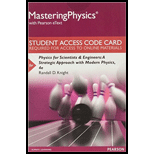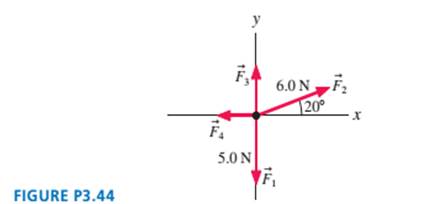
Concept explainers
I Four forces are exerted on the object shown in FIGURE P3.44. (Forces are measured in newtons, abbreviated N.) The net force on the object is

Want to see the full answer?
Check out a sample textbook solution
Chapter 3 Solutions
Mastering Physics with Pearson eText -- Standalone Access Card -- for Physics for Scientists and Engineers: A Strategic Approach with Modern Physics (4th Edition)
- A 150-g baseball is dropped from a tree 15.0 m above the ground. a.)With what speed would it hit the ground if air resistance could be ignored? Express your answer to three significant figures and include the appropriate units. b.)If it actually hits the ground with a speed of 8.00 m/s, what is the magnitude of the average force of air resistance exerted on it? Express your answer to three significant figures and include the appropriate units.arrow_forwardHW1.4. 2D Moment resultant Two forces lying in the x-y plane are defined by their magnitudes and direction angles, as shown in the figure below. Force F₁ has a magnitude F₁ = 360 N, an angle 0₁ = 109°, and acts at point A (310, 0) mm. Force F₂ has a magnitude F₂ = 270 N, an angle 02 = 56°, and acts at point B = (0,385) mm. Determine the total moment about point O due to these two forces. Remember to follow the standard sign convention for clockwise (-) and counter-clockwise (+) moments. y B 10 02 F₂ F₁ A 0₁ X TEGINGENarrow_forwardA crate of mass m = 1.27 kg is on a frictionless incline that makes an angle of θ = 29.3 degrees with horizontal. A force of magnitude P = 9.45 N is applied to the crate in a direction parallel and up the incline, as shown. a. Write an expression for the acceleration ax of the crate, where positive x is up the incline. Your answer should be in terms of m, P, θ, and g (9.80 m/s2). b. What is the acceleration of the crate in m/s2 in the x direction defined in part (a)? c. What is the direction of the net force on the crate? d. What is the direction of the velocity of the crate?arrow_forward
- The International Space Station has a mass of approximately 370,000 kg. (a) What is the force on a 150-kg suited astronaut if she is 20 m from the center of mass of the station? (b) How accurate do you think your answer would be?arrow_forward(a) If AF=BF , can we conclude A=B ? (b) If AF=BF , can we conclude A=B ? (c) If FA=BF , can we conclude A=B ? Why or why not?arrow_forwardA baseball diamond consists of four plates arranged in a square. Each side of the square is 90 ft (27.43 m) long. Use an x y coordinate system with the origin at the center of the diamond as shown in Figure P3.18. a. What is the position of each plate in this system? b. What is the distance from home plate to second base?arrow_forward
- (a) A car with a mass of 850 kg is moving to the right with a constant speed of 1.44 m/s. What is the total force on the car? (b) What is the total force on the car if it is moving to the left?arrow_forwardA car with a mass of 1453 kg is rolling along a flat stretch of road and eventually comes to a stop due to rolling friction. If the car begins with a speed of 10.0 m/s and the car comes to a stop in 6.88 s, what is the coefficient of rolling friction between the tires and the road?arrow_forwardBlock A in (Figure 1) is heavier than block B and is sliding down the incline. All surfaces have friction. The rope is massless, and the massless pulley turns on frictionless bearings. The rope and the pulley are among the interacting objects, but you'll have to decide if they're part of the system. Figure B IIIIIIIIIII 1 of 1 > Part A Draw a free-body diagram for block A. Draw the vectors starting at the black dot. The location and orientation of the vectors ► View Available Hint(s) + 0 ÑA Normal force on A NB on A Normal force from B to A Fc Force of gravity fk B on A Force of friction between B and A fk A Force of friction between A and the incline T Tension Press [ESC] to return to the main menu. Press (CTRL+Q] to quit the application. i ? Activ Go toarrow_forward
- In 2070, Adam wins a vacation at the new Moon Country Club. While vacationing Adam hits a golf ball off a cliff 300 meters high with an initial speed of 40 meters per second at an angle of 45° to the horizontal on the Moon(gravity on the Moon is one-sixth of that on Earth). Round all answers to three decimal places. a. Find parametric equations that describe the position of the ball as a function of time, t (round coefficients to three decimal places). b. How long is the ball in the air? c. When is the ball at its maximum height? What is that maximum height? d. When the ball lands, how far is it from Adam(the horizontal distance the ball traveled)?arrow_forwardThe dragster accelerates from rest down a road of length d = 400.0 m. In the absence of any friction the dragster has a constant acceleration of a = 21.1 m/s2 in the direction of motion, and its mass is m = 1175 kg. Assume the dragster is moving in the positive horizontal direction. a. What is the dragster's final speed, in meters per second, assuming Fr = 1000 N?arrow_forwardThe sport of curling is quite popular in Canada. A curler slides a 19.1-kg stone so that it strikes a competitor's identical stationary stone at 6.80 m/s before moving at an angle of 60.0° counterclockwise from its initial direction. The competitor's stone moves off at 6.40 m/s. Determine the final speed of the first stone V1.f. Vi,f = m/s Determine the final direction of the second stone as an angle a relative to the first stone's initial direction of motion. Let counterclockwise from the first stone's initial direction define the direction of positive angles.arrow_forward
 Physics for Scientists and Engineers: Foundations...PhysicsISBN:9781133939146Author:Katz, Debora M.Publisher:Cengage Learning
Physics for Scientists and Engineers: Foundations...PhysicsISBN:9781133939146Author:Katz, Debora M.Publisher:Cengage Learning University Physics Volume 1PhysicsISBN:9781938168277Author:William Moebs, Samuel J. Ling, Jeff SannyPublisher:OpenStax - Rice University
University Physics Volume 1PhysicsISBN:9781938168277Author:William Moebs, Samuel J. Ling, Jeff SannyPublisher:OpenStax - Rice University Principles of Physics: A Calculus-Based TextPhysicsISBN:9781133104261Author:Raymond A. Serway, John W. JewettPublisher:Cengage Learning
Principles of Physics: A Calculus-Based TextPhysicsISBN:9781133104261Author:Raymond A. Serway, John W. JewettPublisher:Cengage Learning Physics for Scientists and EngineersPhysicsISBN:9781337553278Author:Raymond A. Serway, John W. JewettPublisher:Cengage Learning
Physics for Scientists and EngineersPhysicsISBN:9781337553278Author:Raymond A. Serway, John W. JewettPublisher:Cengage Learning Physics for Scientists and Engineers with Modern ...PhysicsISBN:9781337553292Author:Raymond A. Serway, John W. JewettPublisher:Cengage Learning
Physics for Scientists and Engineers with Modern ...PhysicsISBN:9781337553292Author:Raymond A. Serway, John W. JewettPublisher:Cengage Learning




